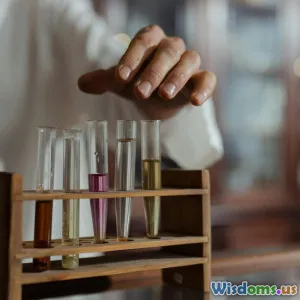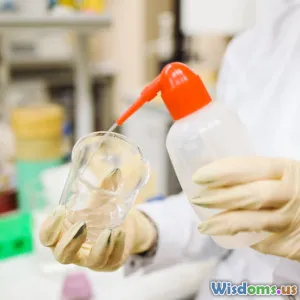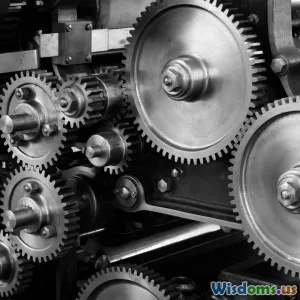
What Happens When Water Meets Sodium A Closer Look at Explosive Reactions
8 min read Explore the dramatic and explosive reaction between sodium and water, uncovering the science, real-world examples, and safety measures behind this powerful chemical encounter. (0 Reviews)
What Happens When Water Meets Sodium: A Closer Look at Explosive Reactions
Introduction
Imagine dropping a small piece of shiny, soft metal into a glass of water and instantly witnessing it burst into flame, splattering sparks, and even producing a loud pop. This dramatic reaction is not mere magic but a vivid display of chemistry in action. When sodium, a highly reactive alkali metal, encounters water, the resulting reaction is explosively vigorous and powerful enough to capture imaginations and caution alike.
In this article, we will dissect the intriguing science behind the sodium-water interaction, explore why the reaction is so energetic, delve into real-world examples and incidents, and discuss essential safety protocols. Whether you are a student, educator, or just curious about chemical phenomena, this narrative will deepen your understanding and respect for the power wisdom yields in a seemingly simple reaction.
Understanding Sodium and Water: Chemical Characters
Properties of Sodium
Sodium (Na) belongs to the alkali metals group — famed for their softness, shiny luster, and extreme reactivity. It's a silvery-white metal, relatively light and easily cut with a knife. What defines sodium is its single valence electron, which it readily loses to achieve a stable electronic configuration. This electron donation results in sodium becoming a positively charged ion (Na⁺), making it highly reactive.
Properties of Water
Water (H₂O) is both familiar and deceptively complex. It is polar, meaning it has a slightly positive and negative end, enabling it to dissolve many substances, especially ionic and polar compounds. Water is also amphoteric with the capacity to participate in chemical reactions as an acid or a base, and it facilitates redox reactions by transferring electrons.
The Chemistry Behind the Explosive Reaction
The Reaction Equation
When sodium meets water, the chemical equation can be simplified as:
2Na (s) + 2H₂O (l) → 2NaOH (aq) + H₂ (g) + energy
Sodium reacts with water to form sodium hydroxide (NaOH), an alkaline solution, and hydrogen gas (H₂).
How the Explosion Happens
The key to the explosive nature is the liberation of hydrogen gas combined with heat (an exothermic reaction). Here’s the step-by-step process:
- Contact and Electron Transfer: Sodium’s valence electron transfers to water molecules, split into hydroxide ions (OH⁻) and hydrogen ions (H⁺).
- Formation of Sodium Hydroxide: Sodium ions bond with hydroxide ions creating the caustic sodium hydroxide.
- Hydrogen Gas Release: Hydrogen ions pick up electrons to form hydrogen gas.
- Heat Generation: The energy discharge is significant, rapidly heating the hydrogen gas.
- Ignition of Hydrogen: The heated hydrogen gas ignites, causing flames and potential explosions.
Why Does It Flame or Explode?
The hydrogen produced can self-ignite if the reaction sustains sufficient heat. The rapid gas release and heat cause pressure to build, often dispersing molten sodium and igniting vapor or hydrogen around it. The reaction’s intensity scales with the size of the sodium piece.
Real-World Instances and Impacts
Laboratory Demonstrations
Science educators often use this reaction to demonstrate chemical reactivity and exothermic processes. A small piece of sodium placed carefully in water produces fizzing, a bright yellow flame, and vigorous bubbling. Such demonstrations underscore fundamental concepts of redox reactions.
Industrial Context and Hazards
Sodium is used in various industries, like chemical manufacturing and nuclear reactors (liquid sodium coolants), due to its excellent thermal properties. Handling it incorrectly or exposure to moisture in the environment can cause devastating fires or explosions.
For example, in 1984, a sodium leak in a fast-breeder reactor in the U.S. caused a fire that necessitated cautious containment efforts. This incident highlighted the reactive hazards of sodium in industrial settings.
Sodium in Nature and Misconceptions
Sodium doesn’t exist as a free metal naturally because it reacts explosively with moisture, including ambient humidity. Instead, it's abundant as sodium ions in compounds like table salt (sodium chloride).
Safety and Handling of Sodium
Storage Guidelines
Given its violent reaction with water, sodium must be stored under inert conditions — typically submerged in mineral oil or in airtight containers — to prevent accidental exposure.
Handling Procedures
Only trained personnel should work with sodium, wearing protective gear, including goggles and gloves. It’s vital to have appropriate fire suppression means, such as Class D fire extinguishers which are designed for metal fires.
Emergency Measures
If sodium contacts water unexpectedly, evacuate the area and use dry sand or specialized powders to suppress flames. Never use water to extinguish sodium fires as this can worsen the situation.
Scientific Insights: Why Sodium Is a Perfect Example
Teaching Electron Transfer
Sodium’s reaction with water vividly teaches the concept of electron transfer, redox processes, and reaction energetics. It bridges abstract concepts with palpable, observable effects.
Demonstration of Reaction Rates and Energy
This reaction exemplifies how different metals vary in reactivity and how energy manifests in chemical processes.
Inspiring Safe Chemical Curiosity
Seeing sodium’s transformation encourages respect for chemicals and the significance of safety measures, crucial in all scientific explorations.
Conclusion
When sodium meets water, the result is a spectacular explosion born from fundamental chemical principles. This reaction is a lively canvas illustrating electron transfer, energy release, and gas evolution, underlying the power lying within elements and compounds.
The practical importance of understanding such reactions extends beyond academics into industrial safety, innovation, and environmental caution. By appreciating these reactions, we not only grasp chemistry but also the responsibilities tied with harnessing nature’s power.
Whether in a lab, industry, or classroom, sodium’s reaction with water remains a breathtaking testament to the dynamic and sometimes dangerous beauty woven into the fabric of our world.
References and Further Reading
- Greenwood, N.N., & Earnshaw, A. (1997). Chemistry of the Elements. Butterworth-Heinemann.
- Zumdahl, S.S., & Zumdahl, S.A. (2014). Chemistry: An Atoms First Approach. Cengage Learning.
- International Atomic Energy Agency (IAEA) Safety Reports on Sodium Coolants.
- Royal Society of Chemistry. Alkali Metals: Overview and Properties
Explore these references to deepen your chemical knowledge and practical insight on elemental reactivity and safety!
Rate the Post
User Reviews
Popular Posts















